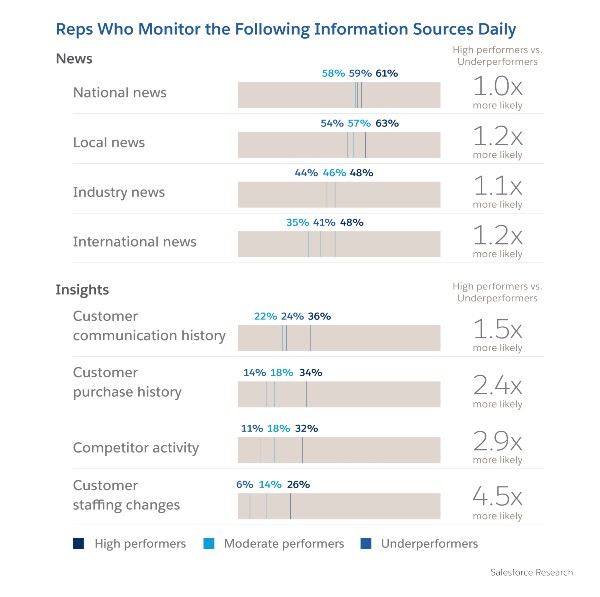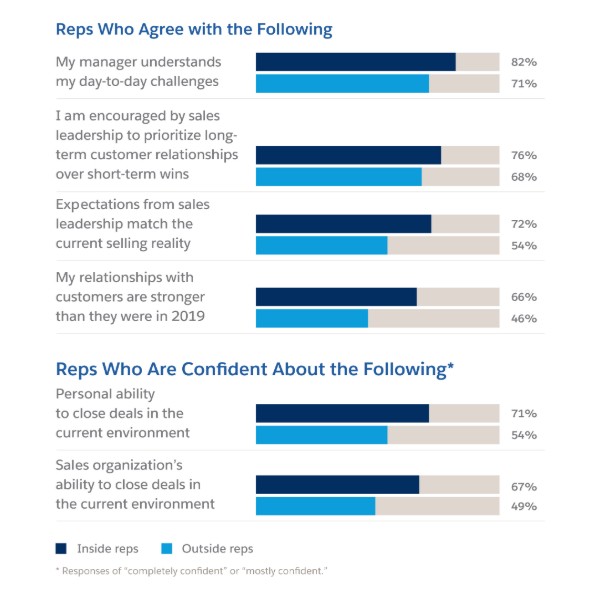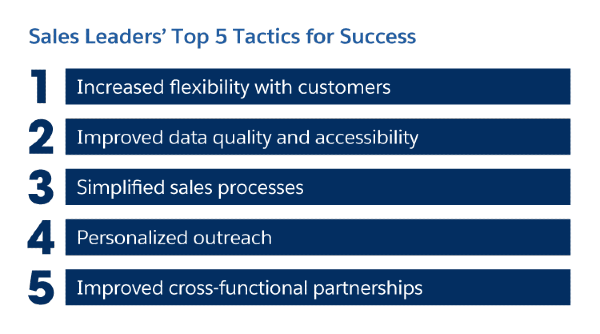4 Sales Trends Changing the Way You Work



It's crisis periods like these that create sales professionals of the future; salespeople that build customer and team relationships which outlast any current situation.
Salesforce Staff
The State of Sales report, just released and based on the insights from nearly 6,000 sales professionals worldwide, reveals the best salespeople are the ones that can evolve alongside the changing selling landscape.
It’s crisis periods like these that create sales professionals of the future; salespeople that build customer and team relationships which outlast any current situation. But as selling goes virtual and buyers’ habits shift, how do salespeople know they are adapting their selling tactics, processes and leadership strategies effectively? We asked nearly 6,000 sales professionals during the crux of global change as part of the fourth edition of the State of Sales report. Here, we share the four key takeaways from the report to help sales reps, sales ops and sales leaders recover and grow.
1. Customer insights close deals
As best-selling author and sales expert Tony Hughes said: “To master the art of sales in this new normal you have to be incredibly good at breaking into a prospect’s world. You have to make the conversation about them and not your product. You need a point of view on how they can improve their business results and you have to talk the language of leaders to avoid getting delegated away.” And this message runs true in the State of Sales findings, with 82% of Australian and New Zealand sales reps saying current economic conditions make it important to anticipate customers’ needs.
So, how can sales reps break into their prospect’s world?
Firstly, reps are immersing themselves in publicly available information from trade magazines, industry podcasts, national and local news. While this is no surprise – a sales rep worth their weight is frequently monitoring public information, in fact, 31% of Australian and New Zealand reps check industry news daily – what is interesting is the types of reps delving into the learnings their team members have accrued from private conversations with customers.
In general, reps on high-performing sales teams are more likely than those on underperforming teams to closely monitor a variety of insights. This is particularly the case when it comes to the kinds of customer-specific insights that aren’t often publicly available, such as communication history, staffing changes, and the like.


2. In a remote-first world, outside reps are now inside reps
COVID-19 turned all salespeople into virtual sellers nearly overnight and according to our report findings, 70% of global organisations are retraining outside reps to sell from home. Instead of onsite meetings, customer lunches, and handshakes, outside reps are now trained to build relationships through a browser window.
But selling during a crisis isn’t easy and many outside reps have struggled with the adjustment. Strikingly, two-thirds of inside reps say their relationships with customers are stronger than they were a year ago, while less than half of outside reps say the same.


While this time carries its fair share of challenges – 65% of Australian and New Zealand salespeople expect their role to be changed permanently – there is also no better time to upskill. For sales reps, it’s also an opportunity to innovate how they connect with their customers. To win the war for attention, sales reps need to go beyond just replicating what they did in face-to-face meetings. They need to be strategic and be led by data. And that means leaning on their colleagues in sales ops.
As technology evolves and insights become more data-driven, sales operations will need a bigger seat at the table to support those emerging needs. The back office is indeed stepping into the spotlight, with 85% of Australian and New Zealand sales professionals agreeing that sales ops is becoming increasingly strategic.
The State of Sales
Insights and trends from over 2,900 sales professionals worldwide



3. AI adoption surges
With 80% of Australian and New Zealand sales leaders saying their digital transformation has accelerated since 2019 – it’s unsurprising that the use of artificial intelligence (AI) within sales teams has taken off. In fact, 37% of global sales teams now report using AI – a 76% increase since 2018. High performers are 2.8x more likely to use AI than underperformers.
The rise in overall AI adoption is partly fueled by the democratisation of AI tools, which are now more widely available and configurable than ever before. According to Nicole Woodley, Regional Vice President at Salesforce ANZ, AI also allows sales professionals to work smarter, not harder. “If you’re able to apply smart automation and AI to delve into your data, then salespeople can use those insights to predict pipeline as well as identify gaps in focus areas.”
Another reason AI adoption is surging: it adds significant value to the sales process, including understanding customer needs, forecasting, and visibility into rep activity.


4. During crises, flexibility is the #1 tactic for sales success
While leaders can’t predict what’s going to happen in the future, it seems Australian and New Zealand sales leaders are glass half-full types of people: 64% are confident about their company’s growth strategy for the next 12 months.
As always, customers are the priority. Adapting to their needs and maintaining flexibility will be the most important tactic in the next 12 months, according to global sales leaders.
Customers face more new challenges than they were just a few months ago with little clarity on what the coming months and years will look like. That means salespeople need to tailor their approach to each customer’s unique situation.


“Establishing a new relationship now is a matter of taking time for empathy – to relate on a human level to what someone is experiencing,” says Ian McAdam, Chief Commercial Officer Australia at Salesforce. For example, you might want to consider different licensing terms, rather than standing firm on pricing.
“Having those conversations is really important – it’s not about just trying to get yes-or-no answers. That’s been quite important for salespeople to learn – there was no sales book for this,” says Ian.
The State of Sales
Insights and trends from over 2,900 sales professionals worldwide



Understand the strategies, tactics and tools of nearly 6,000 sales professionals globally – download the State of Sales report.


















